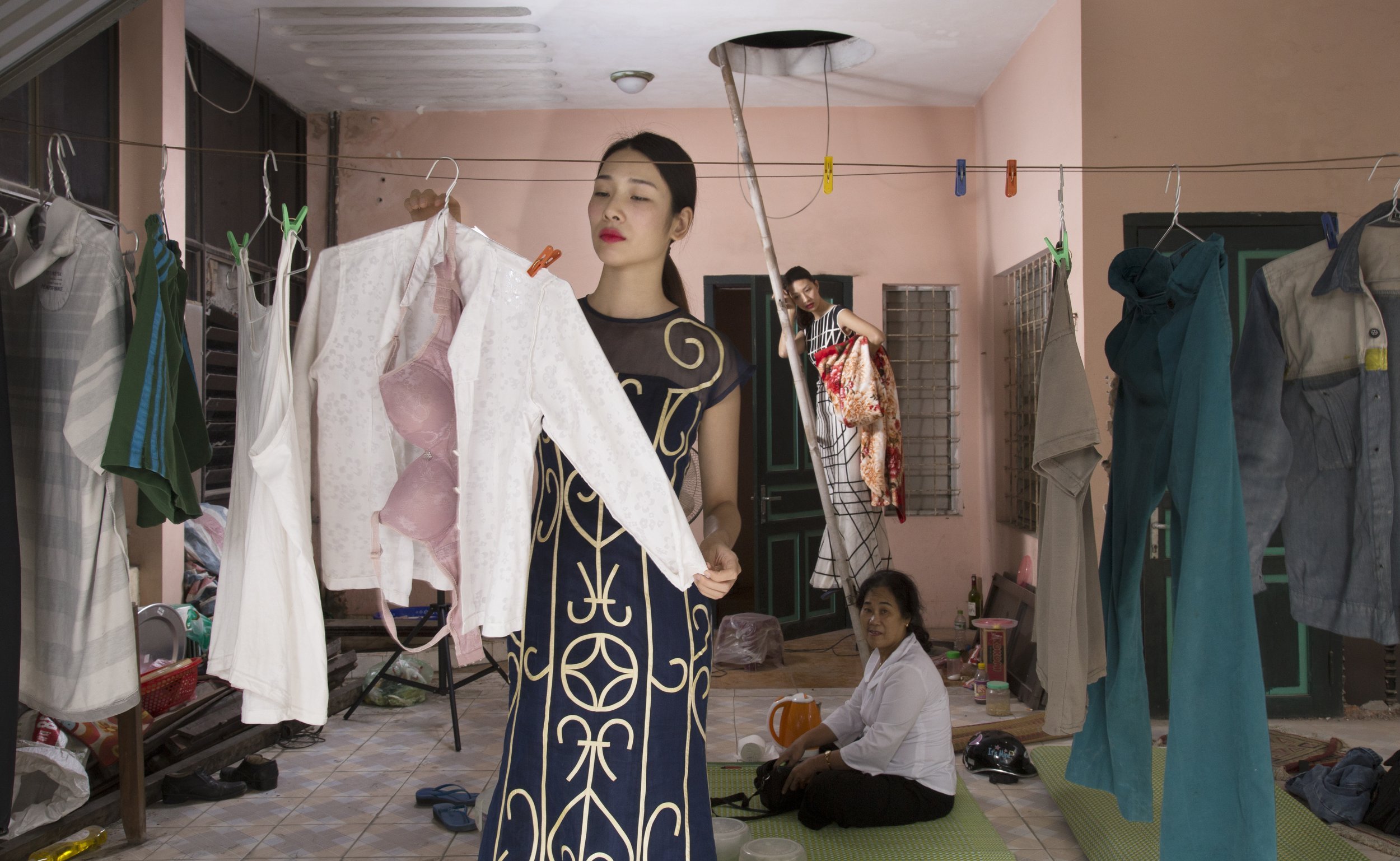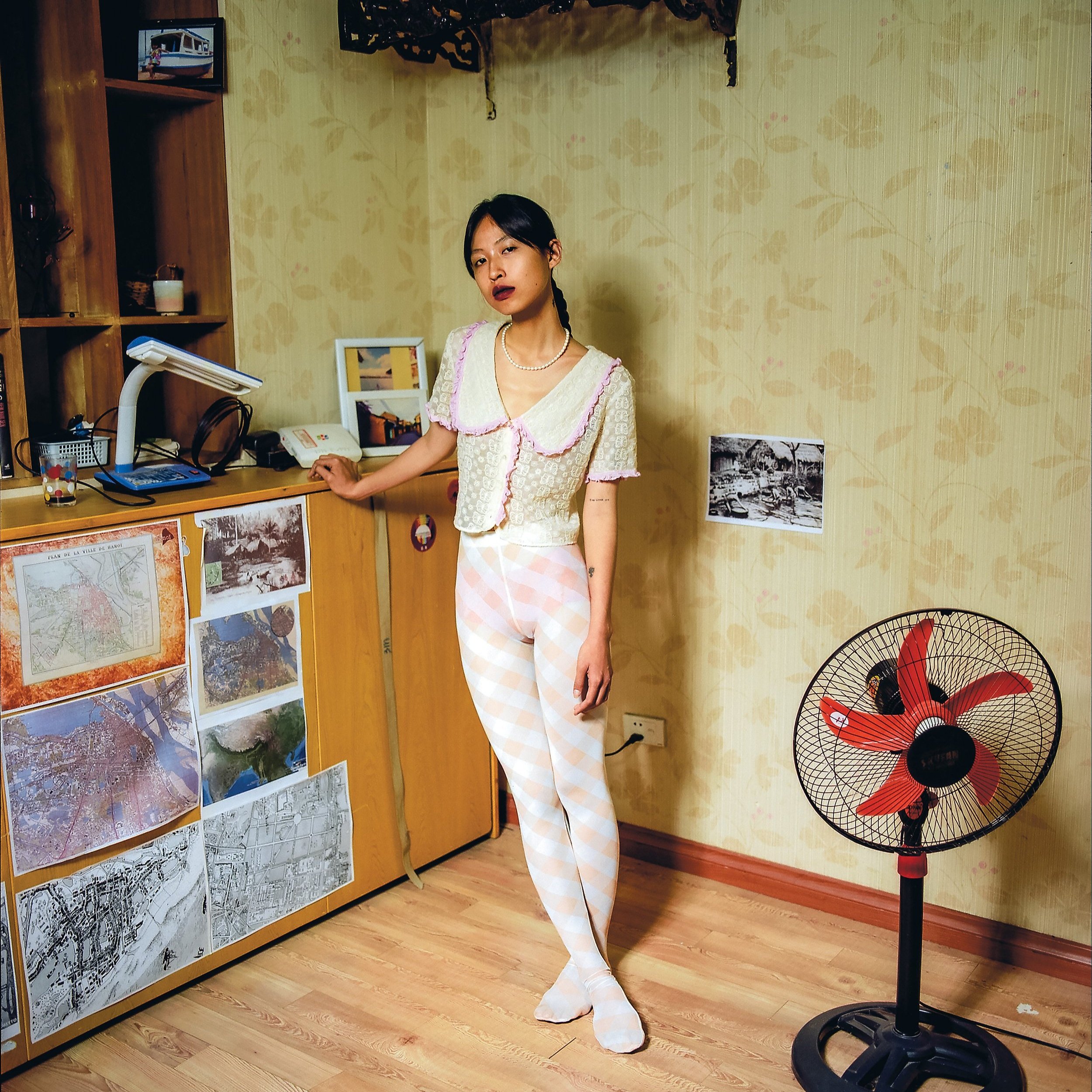Through the Lens: Lac Hoang
Elevating femininity in collaboration with Chula Fashion House
By Woong Soak Teng
‘Through the Lens’ is a series that explores in detail images from fashion image-makers in Southeast Asia, shining a light on their creative and technical processes.
Lac Hoang x Chula Fashion House, featuring Yen Tran and Bui Thao Phuong, 2018. Image courtesy of the artist.
Based in Ho Chi Minh city, the multi-hyphenated, Vietnamese creative Lac Hoang photographs everyday scenes with a touch of theatricality, injecting drama into the mundane. While she is currently taking a break from fashion photography to focus on her practice in advertising and fine art, she took time to reflect on the series ‘Double Burden’, which she created in 2018.
Could you describe this photo series?
The photo series was created in 2018 — a collaboration with Chula Fashion House, which is a fashion brand based in Hanoi, founded by Diego and Laura. It’s actually a collaborative shoot, and not a commercial series. I had an image of women doing repetitive chores together stuck in my head. A predictable scenario in a Vietnamese household, the scene appears quiet and enduring, even oppressive to outsiders, yet something is bubbling underneath the surface. Diego was very generous to sponsor the costumes, as well as the talents. The photoshoot was acted out by two friends of Chula, Yen Tran and Bui Thao Phuong.
Lac Hoang x Chula Fashion House, featuring Yen Tran and Bui Thao Phuong, 2018. Image courtesy of the artist.
'Double Burden' seems to be deeply inspired from your own experience as a Vietnamese woman. Why did you decide to bring your personal narrative into this series and how did you bring the two aspects together?
Yes, I took inspiration from multiple occasions where I witnessed female relatives taking care of housework after family gatherings, while male relatives sat back and enjoyed themselves. This is an example of moments that manifest patriarchy and gender biases commonly seen across households in both cities and rural areas. I imagined women performing their tasks with acceptance and out of habit, but in glamorous and extravagant costumes to highlight the contrast and make it almost celebratory. With reference to the classic Cinderella tale where the restrictive home parallels the glamorous ball, I wanted to recreate the duality in a single scene. Reality is not black and white — are these women really oppressed or is it a faint, lingering remnant from a feudal society? In femininity, there is soft power, where things are not always what they seem to be.
“Reality is not black and white — are these women really oppressed or is it a faint, lingering remnant from a feudal society? In femininity, there is soft power, where things are not always what they seem to be.”
There is a strong intent in picturing the designer pieces in domestic and mundane settings of Vietnam. What are some considerations in the choice of location and everyday activity, in relation to the fashion wear you had to feature?
I purposefully chose my grandma’s kitchen, alongside the courtyard and interior of my parents’ house. An obvious reason was that the locations are domestic and familiar. Grandma’s kitchen was the one I was most proud of, as it’s full of memorabilia, even tracing back to wartime. It’s an interesting contrast to the designer dresses, as Diego also wittily took inspiration from the mundane things that exist in Vietnamese culture. It’s oddly satisfying to juxtapose the artworks (the dresses) with their own sources, like a simulation next to its origin.
Lac Hoang x Chula Fashion House, featuring Yen Tran and Bui Thao Phuong, 2018. Image courtesy of the artist.
Lac Hoang x Chula Fashion House, featuring Yen Tran and Bui Thao Phuong, 2018. Image courtesy of the artist.
How was the collaboration with Chula Fashion House? Who else was involved in the photoshoot?
Diego Cortizas and two model friends of Chula, Thao and Yen, were directly involved in the photoshoot. Ha Dao, a dear friend and curator, writer and photographer at Matca photography collective, was assisting. Thao and Yen were amazing. As professional fashion models, it was fascinating to see them put on unusual roles that were odd and unfamiliar to them. Diego, a well-respected and kind artist, has always been generous to emerging artists in Hanoi and Vietnam at large. Upon hearing my idea, he immediately agreed to support me with Chula dresses and model contacts. I had already imagined scenes of women performing daily chores in fancy gowns, yet the image only came to life after I saw the dresses in the store.
Diego happened to pass away last month — a big loss for Hanoi and its community. Beloved and respected by many, Diego inspired me with his work ethics and passion. I had known Chula for a while prior to the shoot and every time we met, Diego never ceased to impress. He always found new ways to dissect an old subject, considering everything in the final output, including fashion designs, furniture, drawing, photography, poetry and even music. The spirit of Diego and Chula set the tone for the shoot — genuine curiosity, wit, creativity and resilience. I’m grateful to everyone who has made the shoot happen, especially Diego and Chula.
Lac Hoang x Chula Fashion House, featuring Yen Tran and Bui Thao Phuong, 2018. Image courtesy of the artist.
'Double Burden' was made in 2018. How has your photographic style evolved over the past three years? Which fashion photographer’s work has inspired you most in the process?
I’m taking a short break from fashion photo work and working in advertising now, while making works for group exhibitions and teaching drawing on the side. My photographic style has become less flashy after ‘Double Burden’ but it’s still over the top. I would like it to be even more subtle when I pick it up again in the future. The drama can still exist, perhaps with less rawness and theatricality at first glance.
I take inspiration for my fashion photography work from Jeff Wall, particularly for his painterly composition and meticulously staged tableaux. The best part of any photoshoot for me is the pre-production process — from imagining a scenario and researching, to collecting actual pieces and bringing them onto the set. As soon as the moment is captured on camera, I would be elated, but the satisfaction goes away quickly. Once something is framed through a viewfinder and captured, it is no longer exciting to me. This has made me think that perhaps the title of a “photographer” is not best suited for me.
“Once something is framed through a viewfinder and captured, it is no longer exciting to me. This has made me think that perhaps the title of a “photographer” is not best suited for me.”
As an editorial photographer and fine artist, how have your commercial projects influenced your art practice, and vice versa? Do you distinguish them as separate creative spaces, or actively seek to develop both areas in tandem?
I definitely keep them separate. At first, I thought commercial photography could be my main source of income to fund other projects. Later, I realised that staged photography is what I’m excited about, hence the reason for taking a break from it. I’m aware of how ironic it sounds, yet at the moment, I choose to work on something completely different, rather than compromising what I have the most fun with.
See more of Lac Hoang's works here.















